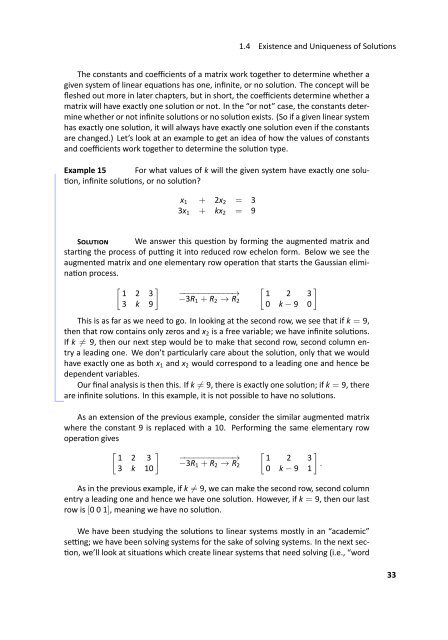Fundamentals of Matrix Algebra, 2011a
Fundamentals of Matrix Algebra, 2011a
Fundamentals of Matrix Algebra, 2011a
Create successful ePaper yourself
Turn your PDF publications into a flip-book with our unique Google optimized e-Paper software.
1.4 Existence and Uniqueness <strong>of</strong> Soluons<br />
The constants and coefficients <strong>of</strong> a matrix work together to determine whether a<br />
given system <strong>of</strong> linear equaons has one, infinite, or no soluon. The concept will be<br />
fleshed out more in later chapters, but in short, the coefficients determine whether a<br />
matrix will have exactly one soluon or not. In the “or not” case, the constants determine<br />
whether or not infinite soluons or no soluon exists. (So if a given linear system<br />
has exactly one soluon, it will always have exactly one soluon even if the constants<br />
are changed.) Let’s look at an example to get an idea <strong>of</strong> how the values <strong>of</strong> constants<br />
and coefficients work together to determine the soluon type.<br />
. Example 15 For what values <strong>of</strong> k will the given system have exactly one solu-<br />
on, infinite soluons, or no soluon?<br />
x 1 + 2x 2 = 3<br />
3x 1 + kx 2 = 9<br />
S We answer this queson by forming the augmented matrix and<br />
starng the process <strong>of</strong> pung it into reduced row echelon form. Below we see the<br />
augmented matrix and one elementary row operaon that starts the Gaussian eliminaon<br />
process.<br />
[ 1 2<br />
] 3<br />
3 k 9<br />
[ ]<br />
−−−−−−−−−−−→ 1 2 3<br />
−3R 1 + R 2 → R 2<br />
0 k − 9 0<br />
This is as far as we need to go. In looking at the second row, we see that if k = 9,<br />
then that row contains only zeros and x 2 is a free variable; we have infinite soluons.<br />
If k ≠ 9, then our next step would be to make that second row, second column entry<br />
a leading one. We don’t parcularly care about the soluon, only that we would<br />
have exactly one as both x 1 and x 2 would correspond to a leading one and hence be<br />
dependent variables.<br />
Our final analysis is then this. If k ≠ 9, there is exactly one soluon; if k = 9, there<br />
are infinite soluons. In this example, it is not possible to have no soluons. .<br />
As an extension <strong>of</strong> the previous example, consider the similar augmented matrix<br />
where the constant 9 is replaced with a 10. Performing the same elementary row<br />
operaon gives<br />
[ 1 2<br />
] 3<br />
3 k 10<br />
[ ]<br />
−−−−−−−−−−−→ 1 2 3<br />
−3R 1 + R 2 → R 2 .<br />
0 k − 9 1<br />
As in the previous example, if k ≠ 9, we can make the second row, second column<br />
entry a leading one and hence we have one soluon. However, if k = 9, then our last<br />
row is [0 0 1], meaning we have no soluon.<br />
We have been studying the soluons to linear systems mostly in an “academic”<br />
seng; we have been solving systems for the sake <strong>of</strong> solving systems. In the next sec-<br />
on, we’ll look at situaons which create linear systems that need solving (i.e., “word<br />
33

















